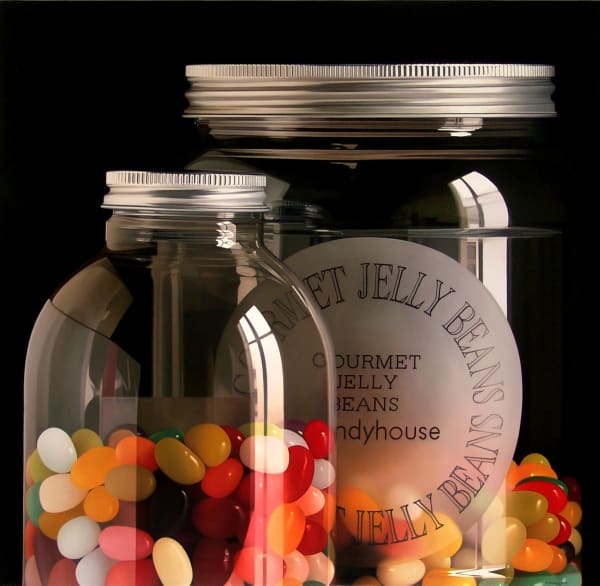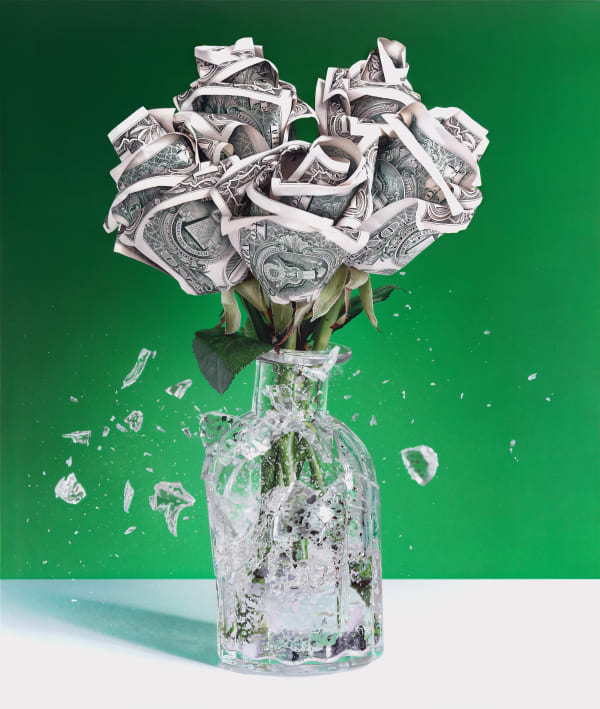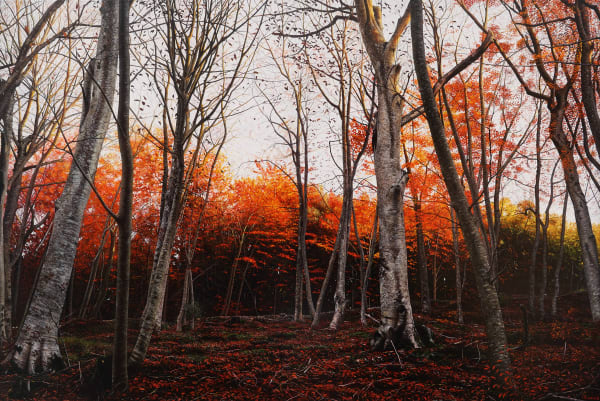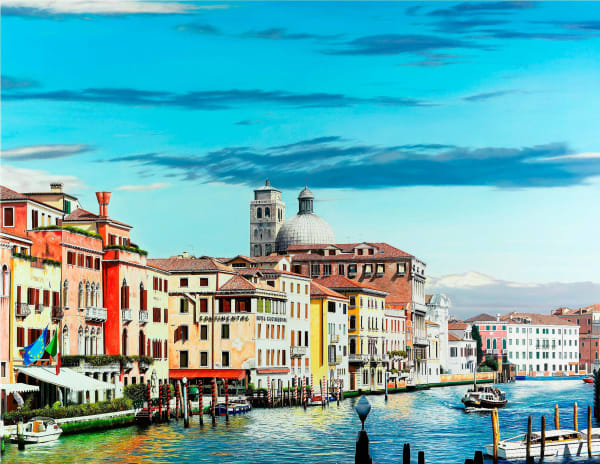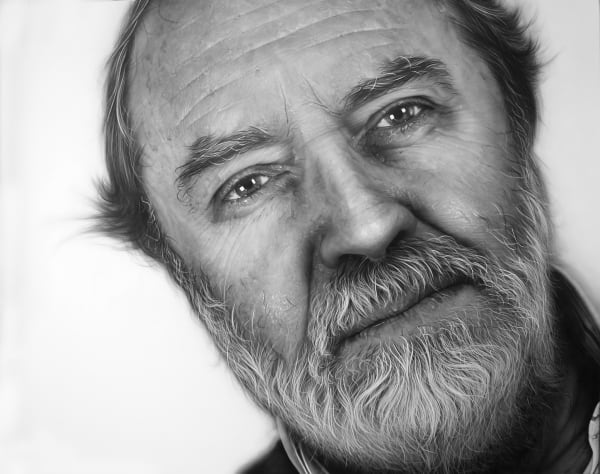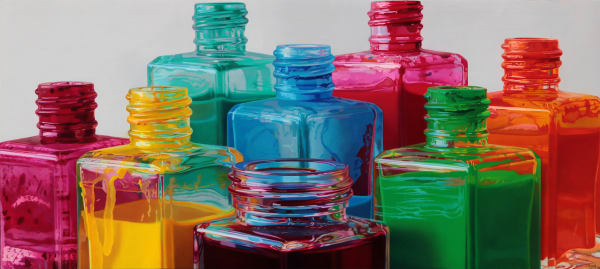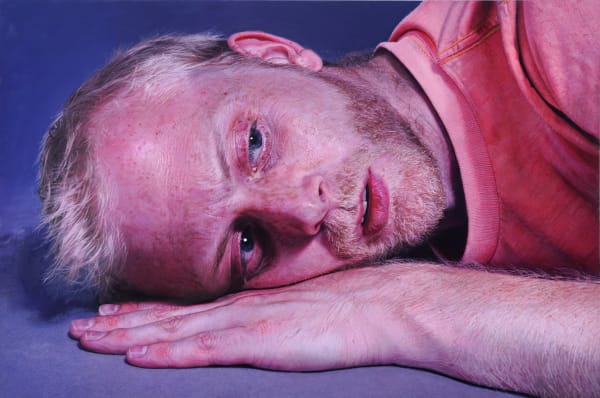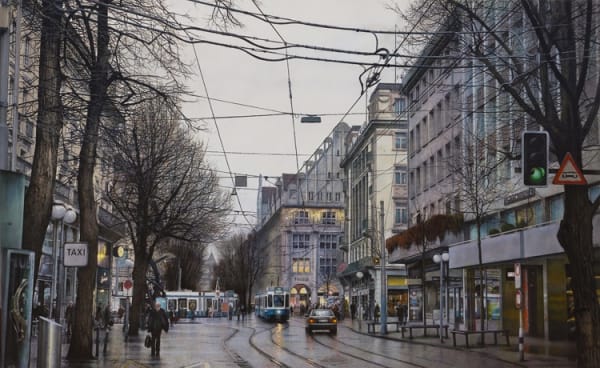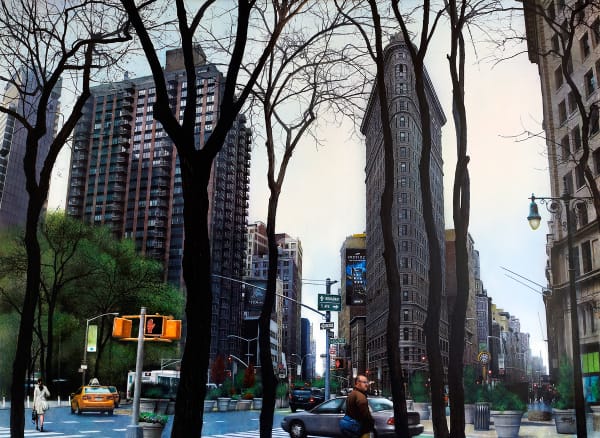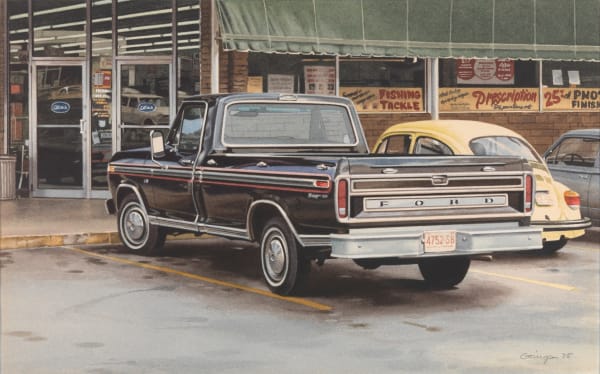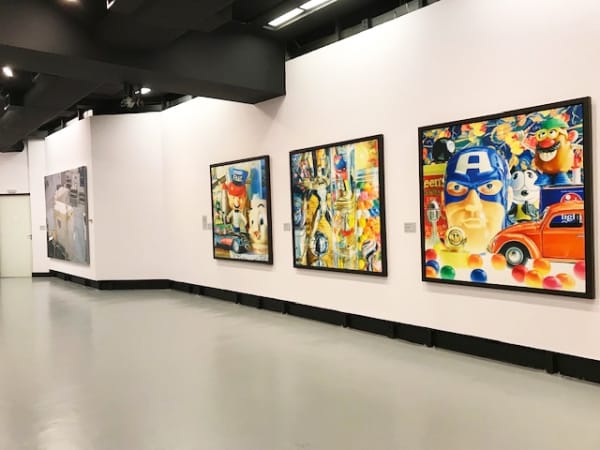50 Years of Realism - Photorealism to Virtual Reality: Rio de Janeiro (21 May - 29 July), Brazil
The aim of ’50 Years of Realism – From Photorealism to Virtual Reality’ is to present to the Brazilian audience a rich exhibition of a few well-established contemporary hyperrealist artists working today, some of whom are showing their work in Brazil for the first time. The exhibition includes works by some of the most renowned artists in the field such as Pedro Campos, Paul Cadden, Craig Wylie and Ben Johnson to name a few. This exhibition also includes works by some of the pioneers of the Photorealist movement of the 1960s and 70s such as Ralph Goings, John Salt, Ben Schonzeit and Richard Maclean.
-
 Pedro CamposJellybean Delight150 x 150 cm
Pedro CamposJellybean Delight150 x 150 cm -
 Pedro CamposHot Dayoil on canvas150 x 150 cm
Pedro CamposHot Dayoil on canvas150 x 150 cm -
 Pedro CamposMacaroon Sensations, 2016Oil on canvas150 x 150 cm
Pedro CamposMacaroon Sensations, 2016Oil on canvas150 x 150 cm -
 Ben SchonzeitGoldmineAcrylic on Linen72 x 72"
Ben SchonzeitGoldmineAcrylic on Linen72 x 72"
183 x 183 cm -
 Ben SchonzeitBlack and Blue BerriesAcrylic on linen183 x 183 cm
Ben SchonzeitBlack and Blue BerriesAcrylic on linen183 x 183 cm -
 Ben JohnsonLeading LightAcrylic on linen183 x 242 cm
Ben JohnsonLeading LightAcrylic on linen183 x 242 cm -
 Ben JohnsonEchoing Sceens127 x 127 cm
Ben JohnsonEchoing Sceens127 x 127 cm -
 Ben JohnsonA Collection of Memoriesx cm
Ben JohnsonA Collection of Memoriesx cm -
 Antonis Titakis, Crashing Wave, 2016
Antonis Titakis, Crashing Wave, 2016 -
 Antonis Titakis, Seascape
Antonis Titakis, Seascape -
 Antonis Titakis, Wave in the Light of the Moon (Diptych), 2016
Antonis Titakis, Wave in the Light of the Moon (Diptych), 2016 -
 Tom MartinCollateral IIAcrylic on aluminium composite panel105 x 115 cm
Tom MartinCollateral IIAcrylic on aluminium composite panel105 x 115 cm -
 Tom MartinEconomical BreakdownAcrylic on aluminium composite panel100 x 120 cm
Tom MartinEconomical BreakdownAcrylic on aluminium composite panel100 x 120 cm -
 Tom MartinPoint of No ReturnAcrylic on aluminium composite panel130 x 110 cm
Tom MartinPoint of No ReturnAcrylic on aluminium composite panel130 x 110 cm -
 Raphaella SpenceAutumn Woods, 2017Oil on canvas120 x 180 cm
Raphaella SpenceAutumn Woods, 2017Oil on canvas120 x 180 cm -
 Raphaella SpenceLa Chiesa di Ponte Naia, 2015Oil on canvas160 x 160 cm
Raphaella SpenceLa Chiesa di Ponte Naia, 2015Oil on canvas160 x 160 cm -
 Raphaella SpencePrimavera, 2011Oil on canvas70 x 90 cm
Raphaella SpencePrimavera, 2011Oil on canvas70 x 90 cm -
 Raphaella SpenceWinter, 2017Oil on canvas60 x 90 cm
Raphaella SpenceWinter, 2017Oil on canvas60 x 90 cm -
 Simon HennesseyPetitAcrylic on canvas160 x 200 cm
Simon HennesseyPetitAcrylic on canvas160 x 200 cm -
 Simon HennesseyThe Duality of Lord ArcherAcrylic and pencil on canvas170 x 140 cm
Simon HennesseyThe Duality of Lord ArcherAcrylic and pencil on canvas170 x 140 cm -
 Simon HennesseyUp Close and Personal with EvangelinaOil on canvas87 x 71
Simon HennesseyUp Close and Personal with EvangelinaOil on canvas87 x 71 -
 Javier BanegasColour Skyline IIIOil on board85 x 190 cm
Javier BanegasColour Skyline IIIOil on board85 x 190 cm -
 Javier BanegasFive Colours IIOil on board61 x 200 cm
Javier BanegasFive Colours IIOil on board61 x 200 cm -
 Francois ChartierLet's Go For a RideAcrylic on canvas147 x 147 cm
Francois ChartierLet's Go For a RideAcrylic on canvas147 x 147 cm -
 Francois ChartierWhere Have I Parked the BatmobilAcrylic on canvas147 x 147 cm
Francois ChartierWhere Have I Parked the BatmobilAcrylic on canvas147 x 147 cm -
 Francois ChartierYou're in Good HandsAcrylic on canvas147 x 147 cm
Francois ChartierYou're in Good HandsAcrylic on canvas147 x 147 cm -
 Craig WylieAb(prayer), 2011-2013Oil on canvas78.7 x 118"
Craig WylieAb(prayer), 2011-2013Oil on canvas78.7 x 118"
200 x 300 cm -
 Craig WylieL(saturated)oil on canvas230 x 180 cm
Craig WylieL(saturated)oil on canvas230 x 180 cm -
 Paul CaddenFor All And NonePencil on Paper63.5 x 40.6 cm
Paul CaddenFor All And NonePencil on Paper63.5 x 40.6 cm -
 Paul CaddenIn the MomentPencil on Paper36cm x 54cm
Paul CaddenIn the MomentPencil on Paper36cm x 54cm -
 Paul CaddenMemoryPencil on paper71 x 46 cm
Paul CaddenMemoryPencil on paper71 x 46 cm -
 Paul CaddenReflections on Having Left a PlacePencil on Paper37 cm x 54 cm
Paul CaddenReflections on Having Left a PlacePencil on Paper37 cm x 54 cm -
 Andres CastellanosBahnhofStrasseAcrylic on canvas162 x 100 cm
Andres CastellanosBahnhofStrasseAcrylic on canvas162 x 100 cm -
 Andres CastellanosShopping Center N.Y.Acrylic on canvas162 x 114
Andres CastellanosShopping Center N.Y.Acrylic on canvas162 x 114 -
 Andres CastellanosFlatiron BuildingAcrylic on board73 x 100 cm
Andres CastellanosFlatiron BuildingAcrylic on board73 x 100 cm -
 David KesslerEvening BalanceAcrylic on panel122 x 213.5 cm
David KesslerEvening BalanceAcrylic on panel122 x 213.5 cm -
 David KesslerGrayed TwilightAcrylic on abraded aluminium on wood122 x 152.5 cm
David KesslerGrayed TwilightAcrylic on abraded aluminium on wood122 x 152.5 cm -
 David KesslerSilvered ReedsAcrylic and resin on abraded aluminium122 x 183 cm
David KesslerSilvered ReedsAcrylic and resin on abraded aluminium122 x 183 cm -
 Ralph GoingsArrow truckWatercolour23 x 30.5 cm
Ralph GoingsArrow truckWatercolour23 x 30.5 cm -
 Ralph GoingsBlack Ford, 1975watercolour on paper20 x 30 cm
Ralph GoingsBlack Ford, 1975watercolour on paper20 x 30 cm -
 Ralph GoingsCoffee shop still lifewatercolour on paper23 x 21 cm
Ralph GoingsCoffee shop still lifewatercolour on paper23 x 21 cm -
 Ralph GoingsDiner ObjectsGouache on paper9" x 12" or 22.8 x 30.5 cm
Ralph GoingsDiner ObjectsGouache on paper9" x 12" or 22.8 x 30.5 cm -
 John SaltFalconOil on canvas116 x 173
John SaltFalconOil on canvas116 x 173 -
 John SaltTrailer with Rocking Horse, 1974-75Watercolour on paperFramed: 68.5 x 78.5 cm
John SaltTrailer with Rocking Horse, 1974-75Watercolour on paperFramed: 68.5 x 78.5 cm
30 x 42 cm
The aim of ’50 Years of Realism – From Photorealism to Virtual Reality’ is to present to the Brazilian audience a rich exhibition of a few well-established contemporary hyperrealist artists working today, some of whom are showing their work in Brazil for the first time. The exhibition includes works by some of the most renowned artists in the field such as Pedro Campos, Paul Cadden, Craig Wylie and Ben Johnson to name a few. This exhibition also includes works by some of the pioneers of the Photorealist movement of the 1960s and 70s such as Ralph Goings, John Salt, Ben Schonzeit and Richard Maclean.
The show offers a fine compendium of the themes and techniques that give Hyperrealism its character. The hyperrealist artist brought about the return of craftsmanship and draftsmanship to contemporary art, which can be seen prominently in these technically astounding works. Grounded in paint rather than theory, these paintings speak for themselves.
Hyperrealism is a distinctly modern movement with obvious antecedents in Photorealism, along with Pop Art and Precisionism. Photorealism was the total rendition and recreation of its subject, taking realism to its literal conclusion. Hyperrealism, by contrast uses the original photograph as a starting point rather than the end goal.
Hyperrealism focuses on the visual reality and beyond, standing as a strong alternative to the conceptual art which has been so dominant within contemporary art practice, it satisfies the visual needs of the viewer. Artists of this genre examine and respond to reality in a very specific way, acknowledging the camera as a tool, and answering to the possibilities it offers to capture a moment in time, and the magic of that instance. The attention to detail, immense precision and amount of skill that goes into these works of art is reflected through the monumentality and diverse subject matter present in the paintings. At times, it can prove almost beyond visual ability.
Broadly speaking within the Hyperrealist movement there are three distinct categories that its practitioners work within: Landscape/ Urban Landscape, Still Life and Portrait/ Human Figure. Each artist’s way of arriving at a painting’s starting point is as unique as the painting itself. This disparate group of artists bring diverse and interesting subject matter to the movement, ranging from Pedro Campos’ monumental tins of Coca Cola to Ricardo Cinalli’s exploration of human suffering. John Salt’s photorealistic depiction of a vintage and decaying American urban landscape shows the viewer the other side of the “American Dream”.
As we live in a world in which everything around us is evolving, we are in a constant state of change and art is no exception. Since the ancient Greeks, intense realism has been an aspiration of Western art and Hyperrealism is a modern response to these figurative traditions.
The hyperrealists of today are documenting this almost daily evolution within our society through the artworks they create. One clear example within this exhibition is Tom Martin’s portrayal of the economic breakdown within our modern world. The way we communicate is inextricably linked with the photograph, the reproduced image and the moving picture, and our personal and cultural sensibility is defined by the way we interact with these images. Therefore, it is no surprise that as human beings we can react, assimilate and appreciate Hyperrealist art.
Hyperrealism hasn’t had an easy ride within the art world. For many years amongst the art elite, less directly visual art movements such as Conceptualism and Minimalism have been preferred for their theoretical concepts rather than their physical artistry but as everything evolves Hyperrealism has finally earned its place and is now being valued as an established movement. It is appreciated for the way in which it acknowledges the visual world that we live in and celebrates the overlooked and intricate details visible in the everyday, the genre itself has progressed leaps and bounds due to technological advancements and a desire for perfectionism.
Hyperrealism is defined as a figurative art form of superlative precision and exceptional clarity. It is the most direct visual expression of art omitting the literal understanding of both abstract and conceptual ideologies, it focuses on the outstanding skill of creating such a heightened replication and intense realism which is almost unbelievable. It has proved to be an optimistic art that asserts humanity’s ability to create beautiful compositions and invent wonderful visions. In short, this is an art form of commitment, passion and self-expression.
The end of the 19th century saw the birth of Photography and the effect it had on the painter, whose skills became redundant in a time when the main purpose of art was to document life, this opened new opportunities for artists as they became free to pursue other possibilities. Photography was utilised to achieve an accurate recording of reality but wasn’t acknowledged as an actual art form until the late 1960s in America.
The initial genre to directly employ the use of photography through commercial advertisements and packaging was Pop Art, followed closely by the Photorealist artists which concentrated on the characteristics of the photograph in their paintings with a visually direct approach and which used the photograph as the only reference point and replicated it to the point of an exact simulacrum of the photo including any photographic effects and defects.
The (predominantly) American Photorealists brought about the return of craftsmanship to contemporary art in the 60s, which is undeniably apparent in the technically outstanding works. The discipline lays within the paint and technical skill rather than theoretical practice, allowing these paintings to speak for themselves whilst portraying the complex diversities in American society. Some even see the rich visual content and almost excessive information present in Photorealism as a reaction to the Minimalist movement (including artists such as; Sol LeWitt, Agnes Martin and Frank Stella) which catalysed the beginning of Hyperrealism.
The term hyper-realism appeared in the early 1970s to describe a resurgence of particularly high-fidelity realism in painting and in sculptures, an exactitude which is explained with clarity in ‘Exactitude: Hyperrealist Art Today’ by Maggie Bollaert, Thames and Hudson. It was a developed idea stemming from the likes of Photorealism and Pop Art but without the confines of both movements.
Hyperrealism, coloured by a European sensibility and depth of Art History, has different qualities to much that has been made in America. The scene has become more diverse in both where it is exhibited and in style and its increased visibility within the art market is proving to be influential on younger artists. There is an international dialogue and followers of leading artists, all of which adds to the momentum, and the notion of a movement.
The movement attempts a realism beyond that of the source: more vivid, more emotive, sharper, brighter. It is selective when it comes to the characteristics of the source photographs, and more responsive, more personal, more flexible than Photorealism. The artists in this movement are not afraid to portray more picturesque compositions whereas Photorealist’s depict a more unequivocal rendition of the photograph.
Although Hyperrealism is clearly aided by the camera, these artists push the boundaries: it is just another tool as is a brush or an easel. The development in digital technology allows them to not only document minute details but also to manipulate the image using computer programs such as Photoshop creating artworks which appear more real than the real thing once painted on their canvases.
If we take the three main areas within the genre it is clear to see that they are all acutely defined by different characteristics. Monumentality plays a significant role in the execution of still life paintings. This is apparent in Pedro Campos’ ‘A Hot Day’ and ‘Black and Blueberries’ by Ben Schonzeit for example. The artists working within this field often favour a combination of both monumental scale and extreme close-ups which delivers a surrealist feel to the final composition.
Another characteristic visible within the Landscape and Urban Landscape paintings is the use of reflection, where we are presented with two images; one real and the other reflected on a variety of surfaces such as water, glass and chrome. Sometimes two or three depictions are present in just one painting. David Kessler’s waterscape painting ‘Evening Balance’ portrays these qualities as the reed’s reflection the water surface.
Portraits have dramatically developed over the years, as the portrait artists of today are using their paintings not only to focus on their subject but depicting social themes as well. ‘Reflections on Having Left a Place’ by Paul Cadden is a perfect example of this contemporary condition.
A technique which runs through the three categories is that there are no brush marks or textures present within these paintings as the Hyperrealists often see this as a way of covering imperfections. Tom Martin’s ‘Collateral’ shows us the extremity of this characteristic through his impeccable finish.
I hope this exhibition has brought you as much joy as it has for me curating it. This is an artform that has been widely over-looked within the artworld, although present through the ages, it is finally being acknowledged by museums, art critics and collectors worldwide. It is the most relevant art movement in western societies as it depicts our everyday lives and touches on subjects I believe we can all relate to. The everlasting presence and evolution of Hyperrealism is secured for as long as the human race exists.


